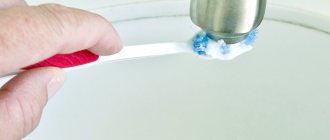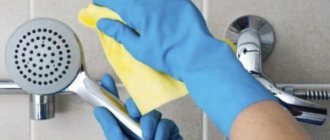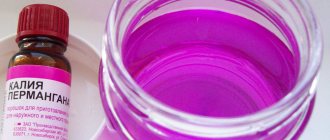Every housewife dreams of an ideal home - cozy furniture, modern home appliances, beautiful dishes and sparkling taps in the kitchen and bathroom. Agree, even the most expensive renovation in the bathroom or kitchen will simply fade if, against the background of the original plumbing fixtures and elegant utensils, there are faucets covered with unsightly lime stains. How to clean your bathroom faucet and what products can help your faucet look like it came straight from the store? You will find answers to these questions in our article.
Cleaning agents for removing limescale
For adherents of household chemicals, the market offers a huge selection of cleaning products for cleaning faucets or mixers from limescale.
Tip: when buying a special powder, carefully study the label. Otherwise, there is a risk of saying goodbye not only to plaque, but also to your own plumbing.
Anti-corrosion inhibitors
Cheap detergents do not contain valuable anti-corrosion inhibitors. Inhibitors prevent aggressive additives from damaging the metal. With them, the entire attack is aimed exclusively at lime deposits. Therefore, look for anti-corrosion inhibitors in the composition of the product.
Sulfuric, hydrochloric or nitric acids
Recommendations for caring for plumbing fixtures
When cleaning chrome-plated taps, mixers and bathroom and kitchen accessories, you can use not only ready-made household chemicals, but also available substances that any housewife has. When purchasing a ready-made product, you need to carefully read the composition and method of use.
It is important that the products do not contain abrasive particles, as well as acids and alkalis that negatively affect chromium. If tap water gets on the surface of the tap and plumbing fixtures, it must be removed in a timely manner so that plaque does not form as a result.
If plaque is not removed, this can lead not only to a deterioration in the quality of work, but also to the failure of plumbing products. And here you can’t do without calling a plumber. You need to get rid of limescale on the faucet in time.
There are the following rules for removing plaque:
- Do not use abrasive materials or substances as they will damage the surface.
- Metallized hard sponges and sponges are not used to clean taps and plumbing accessories. It is almost impossible to remove scratches after them.
- You cannot use products containing sulfuric acid, as well as hydrochloric and phosphoric acid, because their use results in dark stains and rust, which are very difficult to eliminate.
- It is necessary to use special detergents for chrome surfaces.
- You can use a soft toothbrush to clean hard-to-reach areas.
- Special microfiber cloths are available for cleaning chrome finishes.
Return of faucets with damaged chrome plating
The application of this layer is carried out to impart decorative qualities, increase wear resistance and increase strength. A wide variety of materials can be used as a base. In particular, these are plastic and metal.
But even on such a cover defects can form:
- rust. Susceptibility to corrosion is clearly observed in rooms with high humidity (bathrooms and toilets). The influence of temperature changes and high acidity lead to the destruction of the film, but the reaction will take a significant period of time;
- mechanical damage. They are more often found on cars and look like scratches or chips. They also appear on doorknobs and garden decorations;
- white coating. It is formed due to frequent washing with water, which contains some metals. After the moisture evaporates, these substances will settle and accumulate on the object. This also occurs due to high salt content.
You can protect or restore a chrome surface if you follow the established rules. There are a lot of chemicals to care for this surface, and the objects themselves react poorly to sudden changes in climatic conditions.
During operation, we monitor the presence of electrolyte in the brush and, if necessary, add the composition again.
Note! It is recommended to make at least thirty passes of the brush over each surface area. Useful tips
- In some cases, it is not possible to do chrome plating yourself, and then you can choose an alternative way to give the part a spectacular look - nickel plating.
- Chrome plating allows you to reflect the light of the Sun, but over time this property of the treated surface is lost.
- Chromium restoration procedure
- How to care for chrome plating
- Cleaning chrome parts
Restoring chrome previously applied to the surface of a metal or plastic product is not so simple.
Natural flavors
Making an odor absorber for the refrigerator with your own hands is quite simple; you can use available products for this.
A variety of fillers that differ in odor absorption properties, such as table salt and activated carbon, rice and baking soda, can be placed in a box or packaging from a factory device.
You can use lavender sachets for cabinets; it not only smells nice, but also protects against moths. In the kitchen you can use citrus peels, cinnamon sticks or vanilla.
For flavoring, you can use natural coffee. It is advisable to grind the grains to a coarse grind and pour into a plate. You can leave it on the floor or closet overnight, and the next morning the whole room will be filled with the aroma of coffee.
The nuances of cleaning the aerator
An aerator is a special mesh that is found in taps to spray water from the tap. Before cleaning it, remove it and inspect it for various contaminants. If there are too many of them, then use a vinegar solution in which the part should be soaked for 40 minutes.
When cleaning the faucet, do not forget about the mesh filter at the end of the gander, which is called an aerator. It is designed to mix the flow of water with air to increase the volume of flow. This filter most often becomes clogged from debris that passes along with the water through the water pipes. The following phenomena may be a signal that the mesh is clogged:
- Weak or completely absent water flow when valves are open.
- Uneven and non-vertical water flow.
To clean the faucet mesh you need to do the following:
- Unscrew the nozzle using pliers, after wrapping it with a damp thin rag to avoid scratches and chips.
- Apply a rag soaked in vinegar to the nozzle if it does not come off.
- Rinse the filter under running tap.
- Soak the aerator in vinegar for several hours so that the mesh rods are completely cleared of plaque.
- Rinse the vinegar strainer in water and place it back on the faucet.
The shower head is cleaned in the same way, which should be disconnected from the hose, disassembled, cleaned of large debris and soaked in heated vinegar to completely remove plaque. After all this, all that remains is to assemble it in reverse order.
Aesthetics is found in the details
If you have children in your home or you are simply a connoisseur of pleasant little things, then you will definitely like an illuminated faucet aerator. The bodies of such nozzles are usually made of brass with a chrome plated finish.
The design of illuminated aerators assumes the presence inside the housing of a built-in microturbine with an electric generator and a temperature sensor with a diode system. The operating temperature of such a nozzle is up to 60 degrees Celsius.
The illuminated faucet aerator attaches to the faucet spout as simply as a regular one. Screws in by hand, without using tools. When the tap is opened, the jet illumination appears automatically. Its color, as you might guess, completely depends on the current water temperature:
- at temperatures below 29 degrees – green;
- at a temperature of 30-38 – blue;
- at temperatures of 39 and above - red.
The beautiful illumination of luminous aerators will not leave either children or adults indifferent.
Taps in the kitchen and bathroom are constantly in contact with water. As a result, salt deposits form on them, that is, limescale. It deprives the taps of their original cleanliness and shine. White stains appear both outside and inside plumbing fixtures. Over time, the faucet may stop turning altogether due to plaque. To avoid letting your plumbing get into this state, you need to clean it regularly. There are many methods for removing limescale using available materials. So cleaning the faucet at home is not difficult.
In almost any home, the quality of piped water leaves much to be desired. The fact is that this water is very hard. It contains a large amount of calcium and magnesium salts. Water always remains in the tap and at the junctions with pipes. As a result, limescale forms there, that is, deposits of those same calcium and magnesium salts.
It is not always possible to detect plaque in time. Therefore, over time, it turns into water stone, which is very difficult to remove.
The formation of limescale accelerates with frequent use of hot water. Since high temperature promotes the deposition of salts on the surface.
Chicory powder
Restoring bronze faucets to their original matte shine is not so easy, but it is possible.
Plumbing fixtures made of bronze and brass are quite fancy and require special attention. To rid them of dirt, use a solution of chicory powder, brought to a paste-like consistency. After applying the mixture, wait a little so that the dirt begins to succumb to the cleaning components of the product. Next, you need to rinse with warm water and wipe the product until dry.
Specially developed products
You can rid your faucet of unpleasant limescale thanks to specially developed products. You can find them in any household chemical store. When choosing a chemical, pay attention to the following points:
- Use only those options that are designed to care for surfaces, including chrome. Compositions intended for cleaning rust and toilet bowl cleaners are not suitable;
- It is better to choose liquid detergents, since abrasive substances can cause small scratches. This will affect the visual beauty of the faucet;
- When using chemicals, remember to use personal protective equipment. This way you will protect your skin from rashes and your mucous membranes from burns.
Cause of clogged watering can
Before using different methods of removing plaque, try to understand the reason for the decrease in water pressure. In some cases, it turns out that the problem is not in the watering can, but in the hose. If the entire structure is old, then the hose, like the watering can, could also be coated with plaque and needs to be replaced.
PHOTO: archidea.com.ua If simple cleaning with a brush does not produce results, it is necessary to use stronger, more aggressive agents that will remove plaque from the metal surface
There is one simple test method: disconnect the watering can from the hose and put it aside, and then turn on the tap. Does water flow from the hose under good pressure? If so, then the problem is in the watering can, and it needs to be thoroughly cleaned of layers of lime and stone.
First of all, choose the product with which you will clean the watering can. You can use proven household products or try to save money and take the most budget-friendly and affordable products, such as vinegar, citric acid and Coca-Cola. With their help, you can remove plaque no worse than using any solvent.
PHOTO: sdelai-lestnicu.ru In addition to treating with various means, use a toothpick - you can use it to remove plaque from some holes in the watering can. If you do this procedure before immersing in vinegar or citric acid solution, the liquid will better penetrate into the holes, making the treatment more effective.
It doesn't matter what kind of water comes out of your tap. You won't be able to clean it enough to leave your shower accessories completely free of residue. Using filters greatly simplifies the matter, but even in this case it is necessary to treat the watering can at least once every 7-8 months.
If the water in your tap is too hard, then a bottle of vinegar or a packet of citric acid should always be in your kitchen so that when the first layer of plaque appears, you can immediately treat it and remove all contaminants.
Chromium restoration
Most beautiful elements lose their properties and appearance over time, and there are two options left: buying a new one, or restoring an old item. The last point is often used to improve images of historical values and make them more resistant to negative influences. In everyday life, people can also resort to similar methods, because sometimes it is cheaper and faster. But if the question arises of how to restore chrome yourself, then many difficulties arise. The development of modern technologies does not stand still, but there are few reasonable solutions. There are also difficulties with finding equipment and components, lack of time and patience.
And if the question arises about working with a regular faucet in the bathroom, you need to weigh the pros and cons. After all, it’s cheaper and faster to buy a new faucet than to call a specialist and overpay for repairs. And without knowledge of chemistry and physics, it is wiser not to start studying.
It is important to note that sometimes chromium reduction is not a possible process. Irreversible damage or the base on which the layer was applied under special industrial conditions is to blame.
A little bit of science
First, let's study a little what a chrome surface is. In our minds we are always talking about a shiny and mirror structure. Visually everything is correct, but from the point of view of galvanoplasty everything is much more complicated. Chromium itself is not used in its pure form; in the process of applying it to the surface of products, its compounds (solutions) are used. Moreover, chrome plating is carried out on the so-called sublayer, which can be a thin film of copper or nickel. Thus, the resistance of such a surface to destruction is significantly increased. The components of almost all high-quality faucets are presented as follows: the base is brass, the sublayer is nickel and the top is chrome.
On cheap products made from silumin, galvanic application of chromium is difficult to implement, so special varnishes are widely used. This product has nothing in common with real chrome plating, which can be distinguished by its cool blue tint.
In general, when choosing a faucet for a bathroom or kitchen, focus on the weight of the device and the shade of its surface.
How to Clean a Chrome Faucet to Keep It Like New
Chrome plating is a shine and gloss that attracts the eye and ennobles the room. Therefore, such models of mixer taps are very popular. But the more shiny the coating, the faster and easier its appearance deteriorates. That's why we decided to tell you how to clean a chrome faucet so that it shines like new.
From the article you will learn about the intricacies of proper care. We will also tell you how to avoid the appearance of annoying stains. If you are ready, then we begin.
Causes of pollution
In recent years, the quality of water in the water supply has deteriorated significantly. Many people note its toughness. And this is a consequence of the content of mineral and other components. When they get on the surface, they provoke the formation of streaks and white spots. If we are talking about a sink, then this influence is complemented by the presence of soap. As a result, limescale, stains and even stones appear.
Rust appears due to small scratches. Chrome plating protects the metal from oxidation, preventing the access of oxygen. A small amount of damage is enough for the rusting process to begin.
Cleaning with household chemicals
Special products are created taking into account the characteristics of the materials from which the products are made. They perfectly remove plaque, eliminating the possibility of damage to the coating. They differ in the form of release. Depending on it, the method of application changes. The market offers the following types of products:
- gels, liquids, creams or pastes that are applied to a cloth;
- aerosols sprayed directly onto the part;
- powders soluble in water.
Eliminating defects naturally
Not everyone likes the idea of using household chemicals. It may adversely affect the health of household members or have a pungent odor. In addition, specialized cleaning products can cost a lot.
However, there is always a natural, safe and more affordable analogue of store-bought products for household chemicals. Its action will not be so fast, but effective.
So how do you clean a chrome faucet to keep it looking like new using natural ingredients? Ingredients that are present in any home will help you:
- Soap solution. The best thing in this matter is laundry soap. It is rubbed, poured with hot water and the solution is stirred until a homogeneous consistency is formed.
- Baking soda is a guarantee of cleanliness and absence of contamination. This method requires a non-stiff toothbrush. Rub the faucet with sodium carbonate and then wash it. For a better effect, you can additionally wipe it with microfiber.
- Vinegar is an assistant in removing plaque. First of all, make a solution by diluting it with water in a one to one ratio. Then apply to a rag and wipe the device.
- Lemon - helps fight old stains and also has a polishing effect, returning the original consumer characteristics. For cleaning, you can squeeze the juice from a lemon, or buy a ready-made concentrate. Just make sure it's natural juice. Apply it to a rag and wipe the tap. Next, it is washed and wiped with a dry cloth.
- Salt. Allows you to add shine. Please note, it is not recommended to make rubbing movements, just apply it carefully. After this, wait a few minutes and carefully rinse off the salt.
5 cleansing taboos
To maintain cleanliness, consider not only the subtleties of care, but also what things should not be done. Remember that acids react with metal. Due to a chemical reaction, chromium is corroded. Therefore, make sure that there is no perchloric, hydrochloric, acetic, formic and phosphoric acids in the composition.
Some in the fight for cleanliness prefer the “heavy artillery” designed to remove lime and solvents. However, they, like products for purifying lead or silver, are too strong.
To avoid damaging the coating, use specialized products or take this point into account when selecting an alternative. The smoothness of the cloth is also important. Avoid rubbing and using all kinds of powders. They are abrasive and cause scratches. Due to accidental contact of shampoo or gel on a scratch, the metal cracks and peels off.
For clarity, we have compiled a rating of the most dangerous mixtures for products made from chromium. They should not be used under any circumstances:
- acid solutions;
- solvents;
- powders;
- sponges and mechanical impact;
- non-specialized devices.
What to rub on faucets to make water run off?
If you find it, write.
I use “steel shine”... it clearly lasts longer, they shine for a couple of days without strain











